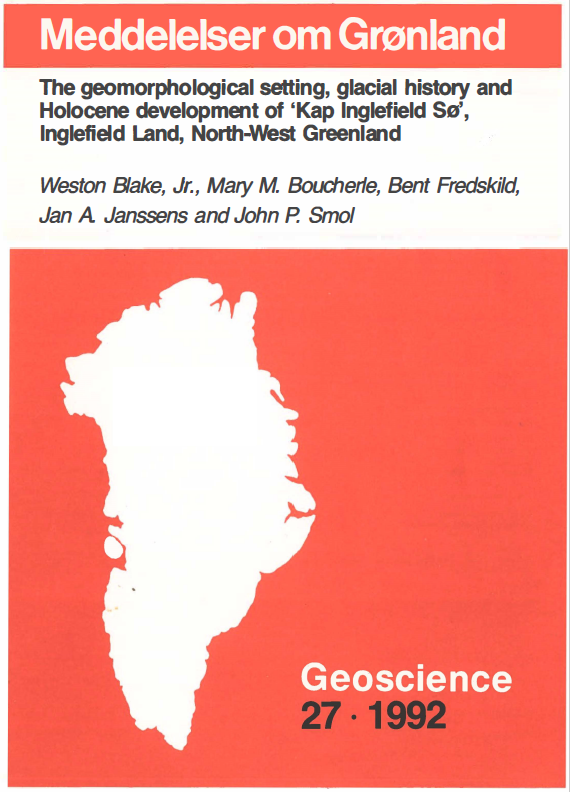The geomorphological setting, glacial history and Holocene development of 'Kap Inglefield Sø', Inglefield Land, North-West Greenland
DOI:
https://doi.org/10.7146/moggeosci.v27i.142025Abstract
A 115 cm-long core was raised from an irregularly shaped lake informally named 'Kap Inglefield Si,f, 1.5 km southeast of Kap Inglefield, North-West Greenland, at an elevation of 150 m. A 49 cm-thick organic sequence is underlain by banded sediment (sand alternating with clay/silt), deposited in an ice-dammed lake. Today the lake is held up at the outlet by bouldery till containing marine shells. The presence of till containing shells with low D/L ratios for aspartic acid at several inland sites, together with well preserved glacial sculpture along the coast (mirrowing features on nearby Ellesmere Island) and over 80 m of Holocene emergence, provides convincing evidence that an ice stream, draining from coalesced Greenland and Innuitian Ice Sheets over Kane Basin, filled Smith Sound at the last (late-Wisconsinan) glacial maximum. Four 14C age determinations have been made on Core 80-18, and the age of the basal organic sediment is 7210 ± 130 conventional radiocarbon years.
The minerogenic sediment in Core 80-18, rich in rebedded pollen, is lacking in contemporary algae and zoological remains, whereas their number varies throughout the organic part of the core, giving some indication of climate and trophic fluctuations. In the organic sequence only 20 diatom species were recorded, and of these only five taxa were ever present at greater than trace levels. The diatom assemblage was dominated by small Fragilaria species, typical of early postglacial environments from most glaciated lakes, regardless of location or geologic substrate. Their continued abundance throughout the history of this lake reflects the extreme climate of the region. These harsh conditions are also reflected in the fossil Cladocera (Crustacea). Fragments of mosses occurred throughout the organic sequence; Calliergon giganteum dominated at most levels between 5 and 40 cm. A pollen- and microfossil diagram can be divided into five zones. From the bottom upward they are: A. Poaceae pioneer plant zone; B. Salix arctica - Polypodiaceae zone with many pioneer plants; C. Salix arctica zone with high pollen influx; D. Cyperaceae zone with Dryas, Oxyria and Salix; and E. Saxifraga oppositifolia - Papaver zone with many pioneer (fell-field) plants. In this uppermost zone up to 250,000 Pediastrum/ml indicate a slow sedimentation rate, as do the age determinations, probably caused by the development of a nearly permanent ice cover over the central part of the lake. Detailed analysis of the top 7 .6 cm of sediment in a second core revealed drastic changes in the chlorophycean (green algae) fossils. Scenedesmus is dominant below 4.7 cm, whereas Pediastrum is dominant above 4.6 cm. An AMS date of 4050 ± 110 conventional radiocarbon years pinpoints the time at which the cover of lake ice became more permanent.

Downloads
Published
How to Cite
Issue
Section
License
Coypyright by the authors and the Commision for Scientific Research in Greenland / Danish Polar Center. No parts of the publications may be reproduced in any form without the written permission by the copyright owners.

